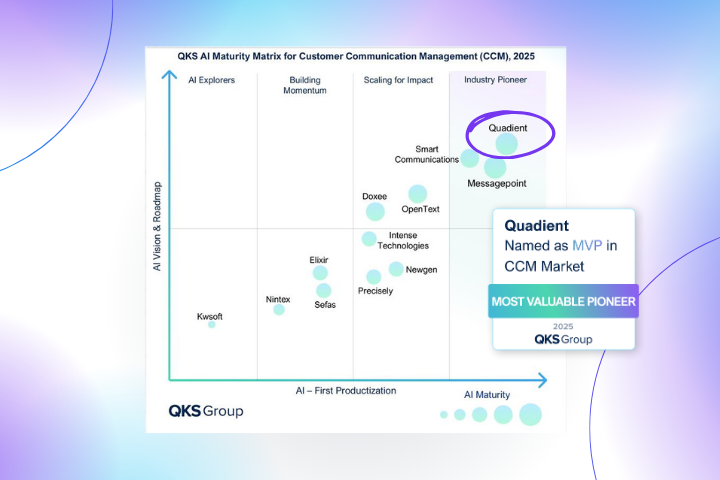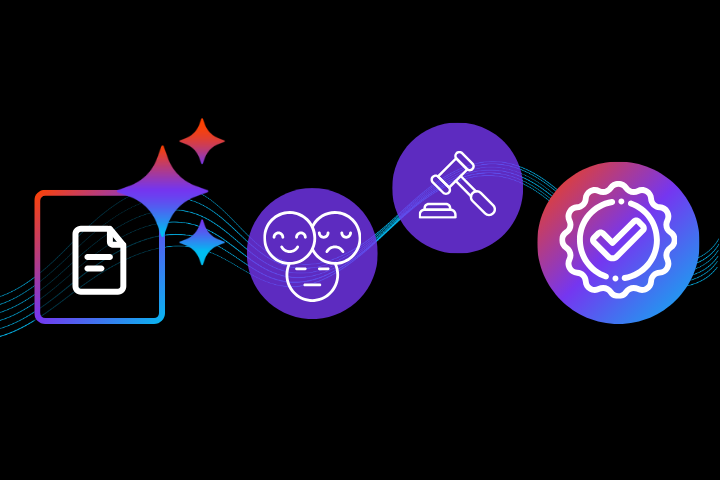Introduction
In healthcare, external factors like rising patient expectations, government mandates such as HIPAA, and a remote workforce add complexity to your document processes.
Many healthcare organizations rely on manual and labor-intensive processes to send critical patient communications such as statements, consent forms, release of information requests, and insurance documents. Now more than ever, healthcare organizations are utilizing document automation to manage and send critical patient communications.
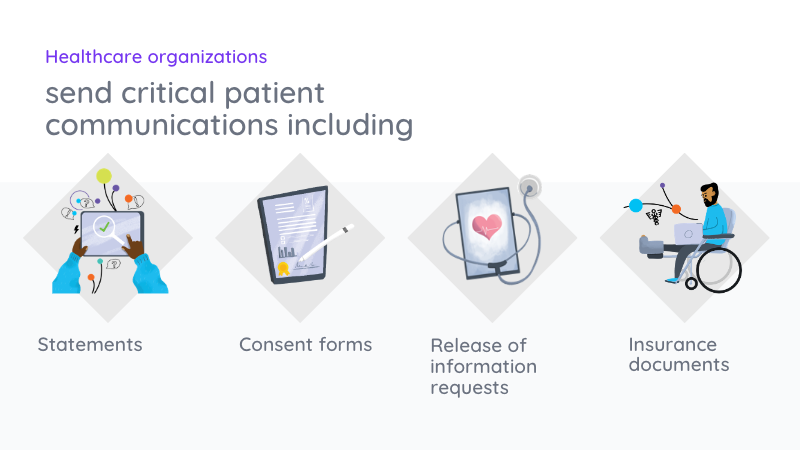
What is document automation for healthcare?
Healthcare organizations require the agility to respond and adapt quickly to patient, regulatory, and business demands. Healthcare document management software automates your entire patient communication workflow. It provides the flexibility to send critical communications through multiple delivery channels – print, digital, or outsource.
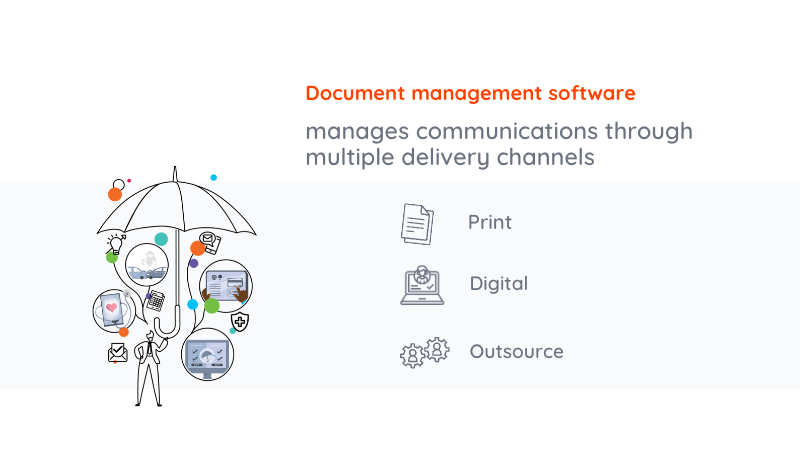
Document automation for healthcare enables efficiencies that are impossible with manual processes and deliver an improved patient experience.
What are the benefits of document automation for healthcare?
The daily life of healthcare professionals was already complicated before the pandemic. Managers of healthcare organizations have faced several structural evolutions. For example, reduced staffing levels have resulted in an increase in their workload, partly due to the exponential rise of administrative tasks.
The most common pain points cited by directors of hospitals and clinics include:
- Lack of visibility into document processes
- Satisfying many stakeholders
- A change in the way the business operates with a greater focus on profit and reducing costs due to increased competition and more demanding patients
One of the most important challenges for the health service industry is the adoption of new technologies. The pandemic highlighted the importance of digitalization and in particular the digitalization of document processes.
According to a study conducted by Forrester Consulting of 450 senior IT and business professionals, since the arrival of COVID-19, decision-makers have changed their perception of digital tools related to document processing. While they had always perceived digitization as an essential operational strategy that allowed them to reduce costs, they now consider digital tools to be strategic for the continuity of their business.

The adoption of a digital document process by healthcare professionals not only enables them to address all the business pains listed above but also delivers significant value across their business. Organizations that exclusively use digital document processes are seeing 5x more improvement in maintaining business continuity than companies with minimal or no digital document processes.
Among the top 5 benefits highlighted in the Forrester study:
- Efficiency gains due to faster document processing
- Improved employee productivity and time savings
- Increased patient satisfaction
- Improved employee collaboration and easier access, and sharing of documents while working remotely
Sources: Global Health Outlook 2020 report, Frost and Sullivan; Forrester Consulting thought leadership paper “How Digital document processes are shifting from best practice to business necessity," August 2020
Document automation software for healthcare
Modern document automation software for healthcare like Quadient’s Impress platform can automate your entire patient communication workflow and give you the flexibility to send critical communications through multiple delivery channels – print, digital, or outsource.
Print: Consolidate mail from your desktop and send to your centralized mail production facility from anywhere
Digital: Send communications digitally through a secure, branded document portal
Outsource: Print, sort, stuff, meter, and mail without leaving your desk through an outsourced hybrid mail solution
Designed to meet the needs of healthcare organizations which require the ability to support both legacy systems and processes, Quadient’s best-in-class suite of hardware and software solutions provide healthcare organizations the agility to respond and adapt quickly to customer, regulatory and business demands.
How to get started with automation in healthcare
The benefits of document automation in healthcare are clear, but how do you get started with automation?
We recommend the following steps when getting started with document automation in healthcare:
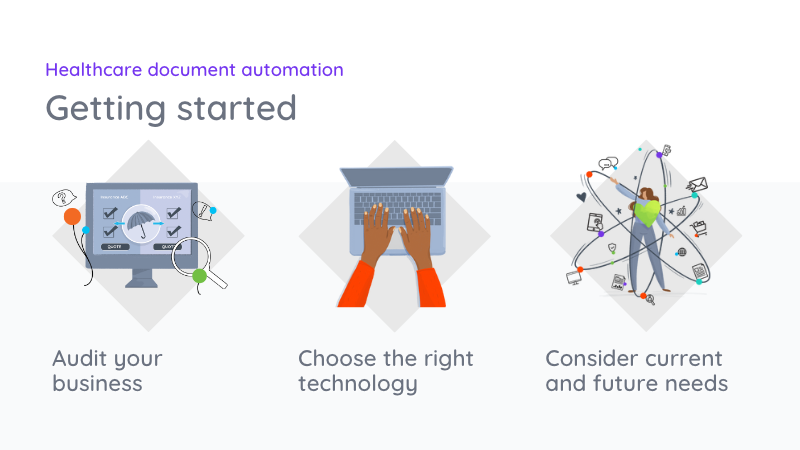
-
Audit your business to determine automation needs
Start by identifying documents that are the most critical, expensive, and labor-intensive to create. These documents will typically be those that greatly impact the patient experience.
Examples of healthcare communications that can be automated include
- Patient Invoices/Collections
- Claims Authorizations & Denials
- Health/Medical Records & Lab Results
- Claim Forms
- Overdue/Late Fee Notices
- Appointment Confirmations
- Checks (Payable & Payroll)
- Explanation of Benefits
-
Choose the right technology
Make sure to choose document automation technology that has extensive integration options so that it works with your existing technology. Select a document automation platform that is user-friendly and that has a simple user interface so that your team can pick it up quickly and won’t revert to the old way of doing things.
Select a technology partner that’s committed to the success of their customers. Review analyst recommendations, ask potential vendors about their customer satisfaction ratings, and check review sites to hear directly from users.
-
Consider current and future needs
Your current needs will evolve over time, so make sure to consider your future needs and select a platform that will grow with you.
Conclusion
Transitioning your healthcare organization from paper-based to automated document processing drives greater efficiency, improves employee productivity, and frees healthcare professionals to focus on patients and positive outcomes. Intelligent document automation reduces the risk of errors that could impact the patient experience, their health, and the practice’s cash flow.





